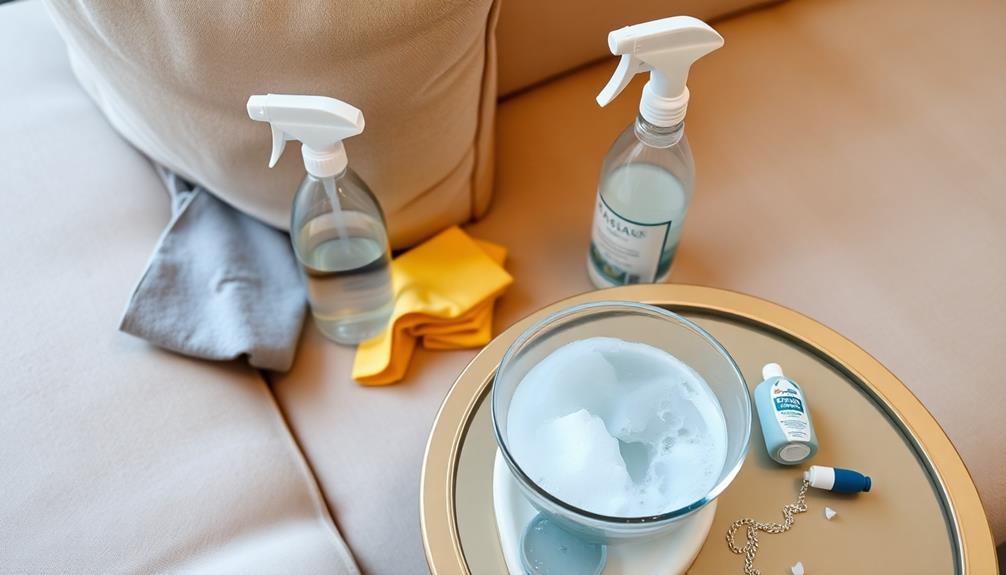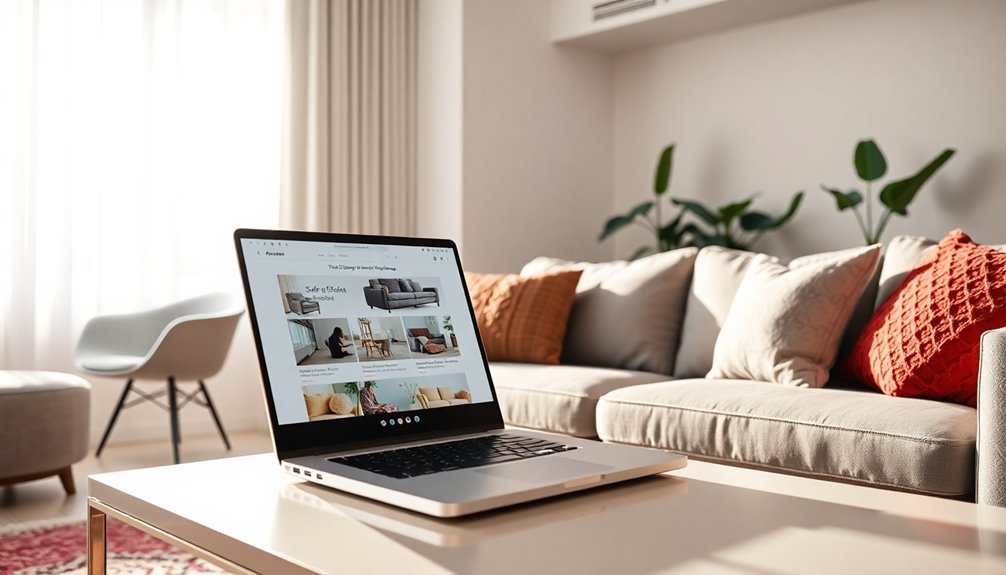In order to clean stains from your sofa, first determine the type of upholstery you have. For fabric sofas, such as those made of cotton or microfiber, create a mixture of dish soap and water and gently dab the stain with a microfiber cloth. For leather sofas, use a leather cleaner and conditioner. Always conduct a spot test beforehand. Stubborn stains can be treated with household items like vinegar or baking soda, especially for food or pet stains. Regular vacuuming will help prevent the build-up of dirt. If stains persist despite your efforts, seeking expert assistance may be necessary for tougher cases. Learning more about proper maintenance techniques can improve your cleaning routine. It is important to avoid saturating the fabric, as excessive moisture can lead to mildew or watermarks. When cleaning a cloth sofa at home, use gentle circular motions to protect the fibers and allow the fabric to air-dry completely. By providing proper care and attention, your sofa will remain in excellent condition for years to come. Familiarize yourself with the manufacturer’s care instructions when cleaning a fabric couch at home to ensure safe methods are followed. Applying a fabric protector or stain repellent after cleaning can help prevent future spills and stains. By sticking to a consistent maintenance schedule, your sofa will retain its appearance and durability, ultimately saving you time and money in the long run. Additionally, incorporating sofa fabric cleaning techniques into your regular cleaning routine can further enhance the lifespan of your upholstery. Consider investing in a high-quality vacuum with upholstery attachments to effectively remove dust and debris from your sofa’s surface. By being proactive and implementing these strategies, you can enjoy a clean and inviting living space while preserving the beauty of your furniture.
Key Takeaways
- Identify the sofa fabric type and follow the manufacturer's care instructions for appropriate cleaning methods.
- Use a vacuum cleaner to remove loose dirt and debris before tackling specific stains.
- For food stains, mix dish soap and water; dab gently with a soft cloth to avoid spreading.
- Always perform a spot test on an inconspicuous area before applying any cleaning solution to avoid damage.
- Consider seeking professional help for persistent stains, delicate fabrics, or heavily soiled upholstery.
Understanding Sofa Fabrics
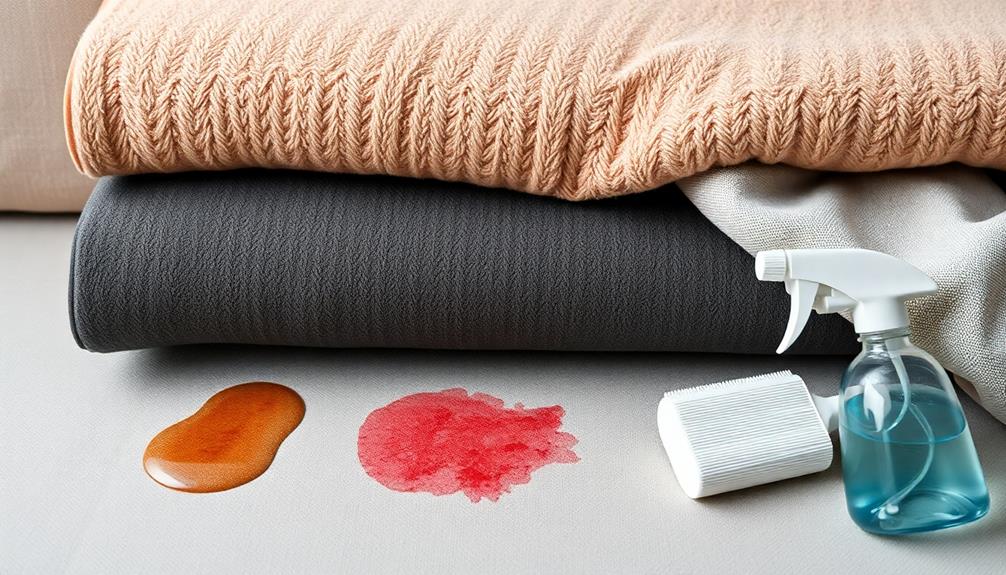
When you understand your sofa's fabric, you can choose the right cleaning method to keep it looking its best. Different upholstery materials, like leather, microfiber, and cotton, require specific cleaning methods to avoid damage and maintain their appearance.
For instance, selecting the best vacuums for dust removal in 2024 can help you maintain a cleaner environment around your furniture. For leather sofas, use gentle, leather-specific cleaners. Regular conditioning is essential to prevent drying and cracking.
Microfiber, known for its stain resistance, can often be cleaned with water-based solutions. However, it's wise to test for colorfastness before applying any cleaner. On the other hand, cotton sofas are comfortable but prone to stains, often needing professional cleaning to tackle tougher blemishes effectively.
To guarantee you're using the right approach, always check the manufacturer's care tags for cleaning instructions. These tags provide vital guidance on the appropriate cleaning methods for each fabric type, helping you avoid costly mistakes.
Essential Cleaning Supplies
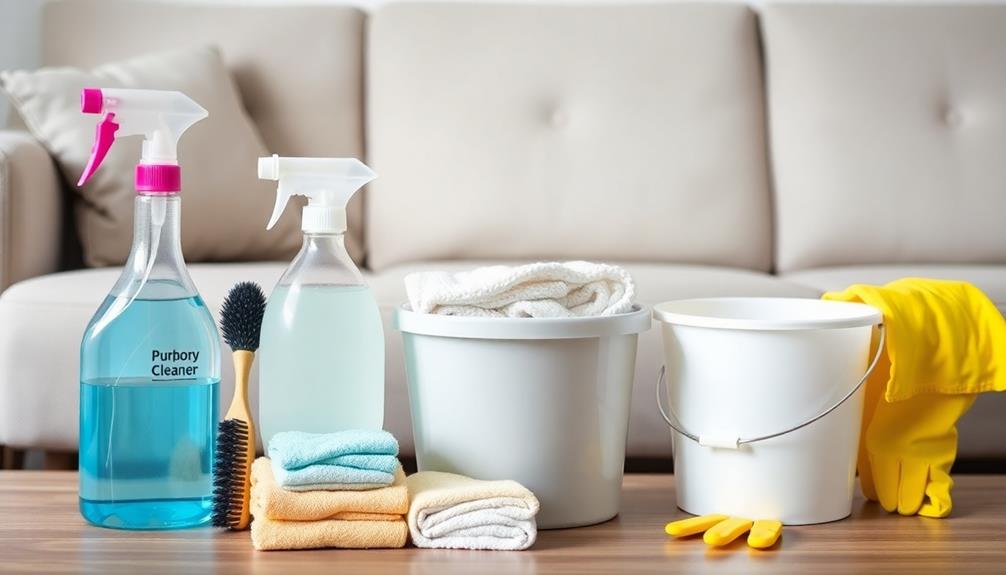
To effectively tackle sofa stains, having the right cleaning supplies on hand is vital. Start with a vacuum cleaner to remove loose debris and dirt from your upholstery.
Next, gather microfiber cloths, as they're perfect for blotting stains and applying cleaning solutions without scratching the fabric. Incorporating natural cleaning agents, such as essential oils for various uses, can enhance your cleaning routine and provide additional benefits, like antimicrobial properties.
For your cleaning agents, keep dish soap, white vinegar, and baking soda handy. These items can work wonders on various stains and odors. A bucket will be useful for mixing your cleaning solutions.
If you encounter stubborn stains, a stiff brush can help scrub them out without damaging your upholstery.
Don't forget a spray bottle! It's vital for applying homemade solutions quickly, allowing you to address stains as soon as they occur.
If your sofa is leather, make sure you have a gentle leather cleaner and conditioner to maintain its integrity and prevent it from drying out.
Stain Removal Techniques
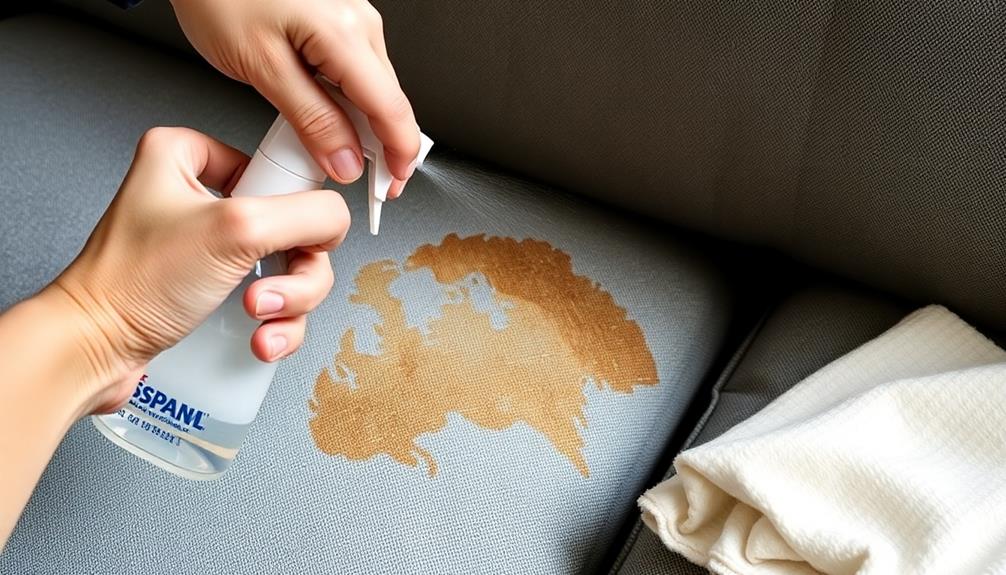
Tackling sofa stains starts with identifying the type of stain you're dealing with, as each requires a specific removal technique.
It's also important to take into account the fabric of your sofa, as different materials may react differently to cleaning solutions.
Here are some effective stain removal techniques you can use:
- Food Stains: Mix dish soap and water to create a cleaning solution. Use a soft cloth to gently dab the area, avoiding excess moisture to prevent damage to the fabric.
- Beverage Spills: For water stains, a solution of vinegar and water works well. Blot spills immediately with a dry microfiber cloth to lift the stain before it sets.
- Ink Stains: Rubbing alcohol is your best bet. Apply it to a soft cloth, then dab the ink stain, being careful not to rub and cause further damage.
- Pet Stains: Enzymatic cleaners are effective for breaking down pet stains and odors, which can be similar to the way certain cold medications target specific symptoms. Follow the instructions carefully to guarantee thorough cleaning.
Always perform a spot test on an inconspicuous area before applying any cleaning solution.
For tougher stains, take into account using an upholstery steam cleaner to refresh the fabric while adhering to the manufacturer's cleaning techniques.
Odor Elimination Methods
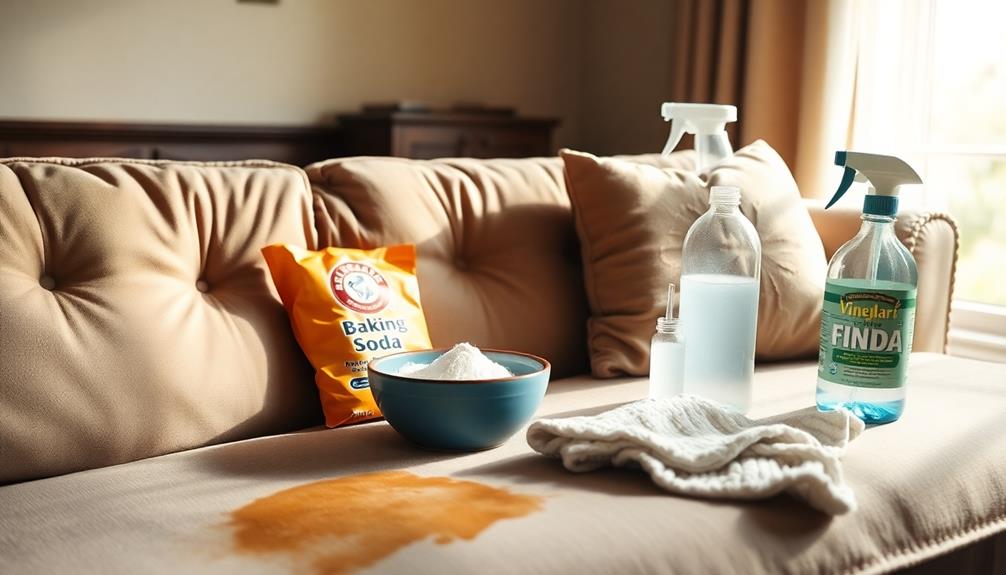
Sofas can easily trap odors from pets, spills, and everyday use, making it essential to address these smells for a fresh living space. To effectively remove odors, start with baking soda. Sprinkle it generously over your couch and let it sit for 20 minutes to an hour. This natural deodorizer absorbs unpleasant smells, leaving your sofa fresher.
Additionally, ensuring proper airflow around your sofa can also help enhance the effectiveness of your odor elimination methods, similar to how air purifier maintenance supports better indoor air quality.
For more stubborn odors, mix equal parts of vinegar and water. Use this solution as a cleaning product by applying it with a cloth, ensuring you don't soak the fabric. Vinegar neutralizes odors without leaving a strong scent once it dries.
If you want to go deeper, consider steam cleaning. A handheld steam cleaner can penetrate the fabric fibers, effectively sanitizing and eliminating lingering odors.
To maintain a fresh-smelling sofa, incorporate regularly scheduled deep cleanings every 12 to 18 months. This practice will help prevent odor buildup and keep your couch looking and smelling its best.
Deep Cleaning Your Sofa
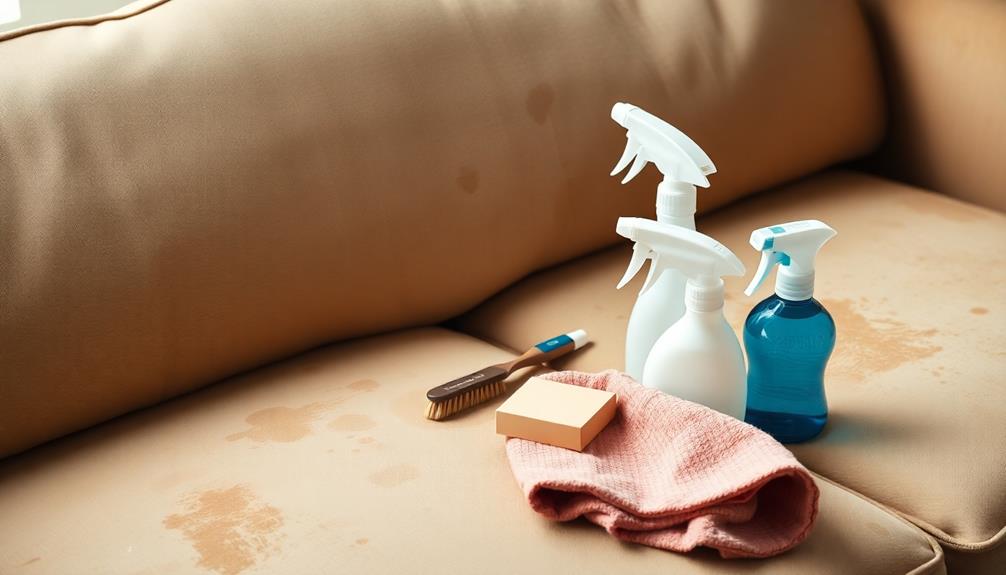
To keep your sofa looking great, start with regular vacuuming to remove crumbs and dirt.
Incorporating effective natural ingredients for grout cleaning can also enhance your overall cleaning routine.
For tougher stains, try spot cleaning with the right techniques and solutions to tackle those problem areas.
Don't forget about odor elimination methods to guarantee your sofa stays fresh and inviting.
Vacuuming and Debris Removal
When it comes to deep cleaning your sofa, vacuuming and removing debris are essential first steps. Regular vacuuming helps prevent dirt and stains from embedding in your upholstery, maintaining ideal cleanliness. Additionally, proper diet for pets may help reduce pet-related messes on your furniture.
To effectively clean a fabric sofa, follow these steps:
- Remove Sofa Cushions: Start by taking off the cushions. This allows you to clean all surfaces thoroughly.
- Vacuum the Surface: Use a hand vacuum or brush attachment to clean the sofa's surface, making sure to reach all corners and crevices.
- Focus on Overlooked Areas: Pay special attention to areas like under the cushions and between the seams. These spots often collect crumbs and pet hair.
- Check for Spills and Stains: While vacuuming, look for any spills and stains that may need further attention later.
Spot Cleaning Techniques
For effective spot cleaning, start by vacuuming your sofa to eliminate loose dirt and crumbs, which helps you gauge the severity of any stains. Once you've assessed the stains, prepare a cleaning mixture using mild detergent, baking soda, and vinegar with warm water. Apply this solution directly to the stained area, and let it sit for about 10 minutes. Always remember to gently blot the stain with a microfiber cloth instead of rubbing, as this prevents damage and allows the solution to absorb properly.
Before applying any cleaning solution to visible stains, perform a spot test on a hidden area to check for colorfastness. If you encounter tough stains, using a handheld steam cleaner can be your best bet; the steam helps loosen embedded dirt, making it easier for your cleaning solution to work effectively.
Here's a quick reference for your spot cleaning techniques:
| Cleaning Solution | Notes |
|---|---|
| Mild Detergent & Water | Gentle on fabrics |
| Baking Soda & Vinegar | Effective for stubborn stains |
| Distilled Water | Use for rinsing |
| Steam Cleaner | Excellent for tough stains |
Odor Elimination Methods
A fresh-smelling sofa can greatly enhance your living space, making odor elimination an important part of your cleaning routine.
Sofa fibers can trap odors from spilled wine, pets, and more, so you'll want to use effective methods to keep it fresh. Additionally, choosing the right cleaning methods can contribute to the longevity of your furniture, much like how energy-efficient models can enhance the reliability of heat pumps.
Here are four odor elimination techniques you can try:
- Baking Soda: Sprinkle baking soda over your sofa and let it sit for 20 minutes to 1 hour. This natural ingredient absorbs unpleasant smells, making it a great homemade solution. Vacuum it up afterward.
- Handheld Steam Cleaners: These tools can penetrate deep into the fabric, neutralizing lingering odors effectively. They're perfect for regular deep cleaning.
- Natural Fabric Cleaners: Opt for cleaners made from natural ingredients that eliminate bad odors rather than just masking them. This guarantees a fresher scent in your living space.
- Sofa Cover Care: If your sofa cover is removable, wash it regularly to remove dust and odors. This simple step can make a big difference.
Incorporating these methods into your routine helps maintain a clean and inviting environment.
Maintenance Tips for Longevity
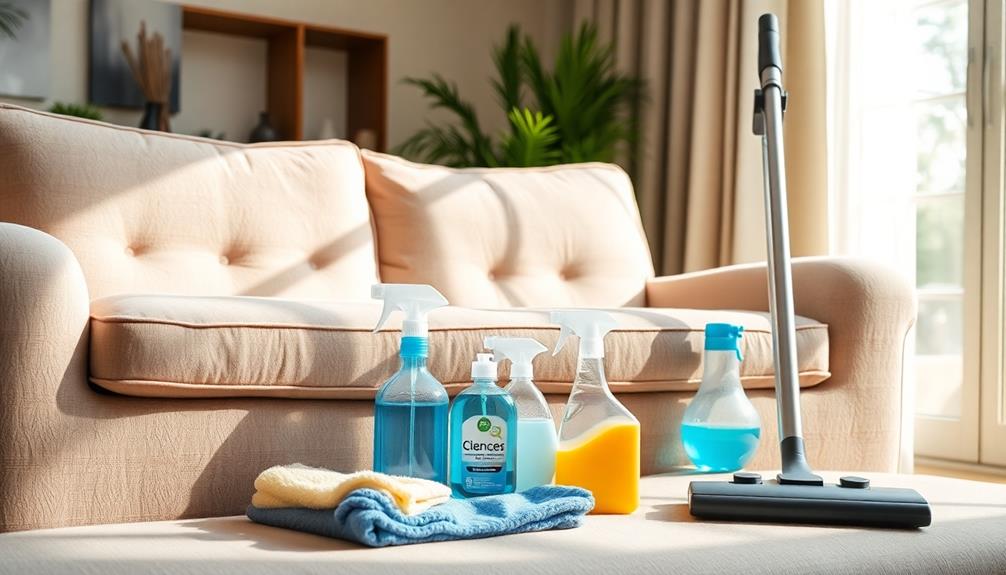
Maintaining your sofa's longevity is essential for keeping it looking fresh and new. One of the best maintenance tips is regularly vacuuming your sofa every 1-2 weeks. This helps prevent dirt and crumbs from embedding in the upholstery, extending its lifespan. Incorporating stress management techniques can also help you create a relaxing environment, which may lead to less clutter and spills on your furniture.
Don't forget to use a brush attachment to gently remove debris from fabric fibers.
Every 12 to 18 months, consider deep cleaning your sofa to maintain its appearance, especially if it's a high-use piece or if you have pets. If you're concerned about spills and stains, using sofa covers can provide an extra layer of protection, making it easier to clean a couch.
Additionally, make it a habit to rotate and flip your cushions periodically; this helps distribute wear evenly and keeps your upholstery looking great. After cleaning, applying a fabric protector creates a barrier against future stains, simplifying regular maintenance.
If you notice any spots, tackle them immediately with spot cleaning to prevent permanent marks. By following these simple steps, you can guarantee your sofa remains a cozy and attractive centerpiece in your home for years to come.
When to Seek Professional Help
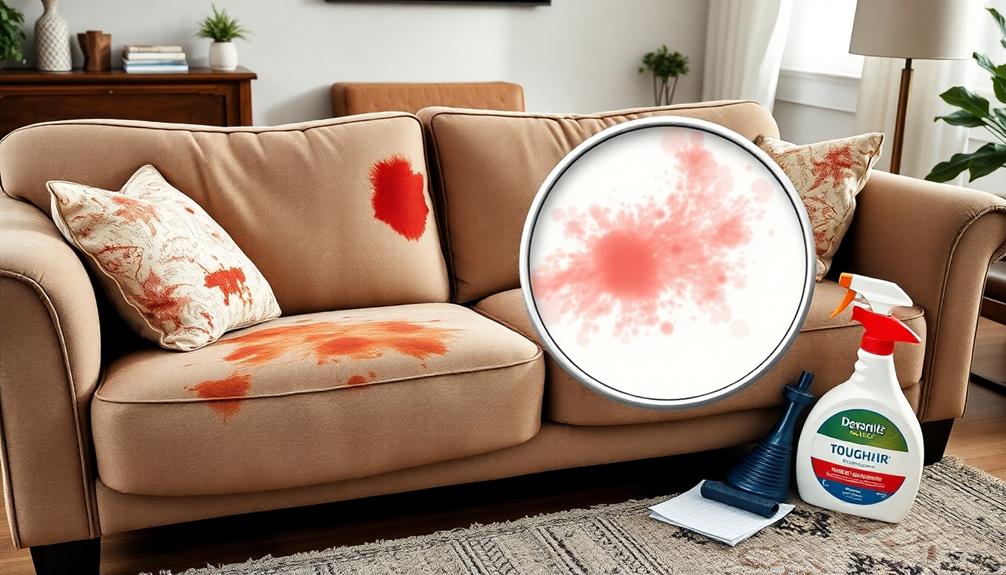
Knowing when to seek professional help for your sofa can save you time and prevent further damage. Here are four scenarios where it's wise to call in the experts:
1. Persistent Stains: If you've tried multiple cleaning methods on stubborn stains like red wine or ink and they're still visible, it's time to get professional help.
They've access to stronger, specialized cleaning solutions that can tackle these challenges, similar to how careful budgeting can help manage financial issues effectively.
2. Delicate Fabrics: For sofas made of delicate fabric, professional cleaners understand how to treat them without causing damage.
They know the right cleaning methods and tools to use, ensuring your sofa stays in great shape.
3. Heavy Soil and Odors: If your sofa is heavily soiled or has lingering odors that DIY methods can't eliminate, professionals use advanced tools and techniques for effective deep cleaning.
4. Lacking Care Instructions: If you have an antique or vintage sofa without cleaning instructions, experts can provide the specialized knowledge needed for safe sofa cleaning.
Don't hesitate to reach out for professional help when these situations arise.
It's an investment in the longevity and appearance of your sofa.
Frequently Asked Questions
How Do You Get Stains Out of a Fabric Couch?
To get stains out of your fabric couch, start by vacuuming it. Identify the fabric type, then apply a cleaning solution of dish soap and vinegar directly to the stain, blotting it with a clean cloth.
What Is the Best Way to Clean a Fabric Sofa?
You won't believe how easy it is to make your fabric sofa look brand new! Start by vacuuming, check the care tag, and use a gentle cleaning solution to tackle those pesky stains—your sofa will thank you!
Can Old Stains Be Removed From a Sofa?
Yes, you can remove old stains from a sofa. Use a mixture of washing-up liquid, vinegar, and warm water. Apply it, let it sit, then wipe away the residue for better results.
Can I Use Dawn Dish Soap to Clean My Fabric Couch?
Yes, you can use Dawn dish soap to clean your fabric couch. Just mix a few drops with warm water, apply it with a microfiber cloth, and remember to blot gently to avoid damage.
Conclusion
In your quest for a spotless sofa, remember that regular care is the key to keeping it looking fresh and vibrant. Just like a garden needs sunlight and water, your sofa thrives on attention and maintenance. With the right cleaning supplies and techniques, you can tackle stains and odors with ease. If things get too tough, don't hesitate to call in the pros. A clean sofa isn't just furniture; it's the heart of your home.
